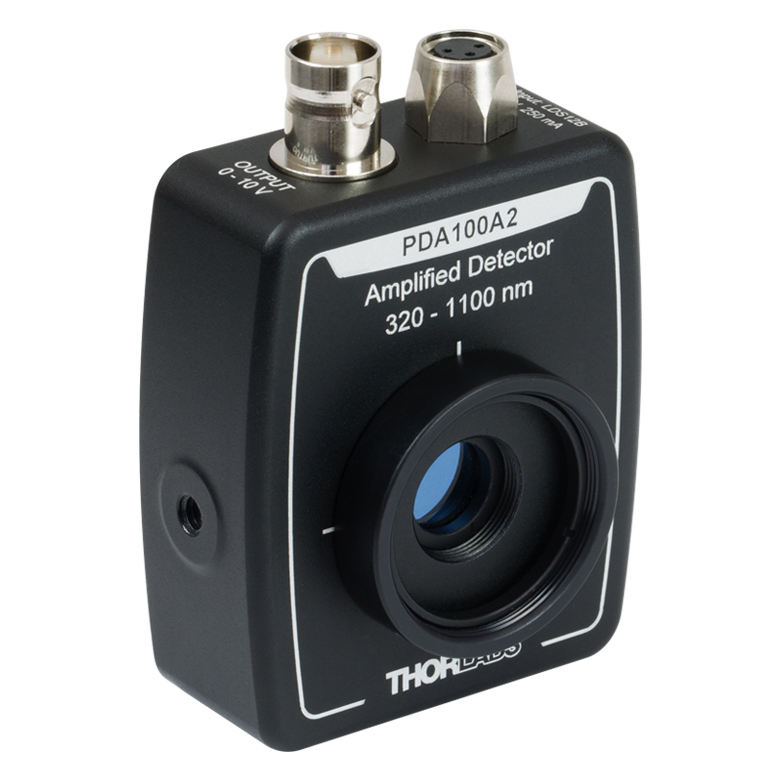Photosensors or photodetectors are sensors of light or other electromagnetic energy. There are several varieties:[1|http://en.wikipedia.org/wiki/Photodetector#cite_note-0]
- Optical detectors, which are mostly quantum devices in which an individual photon produces a discrete effect.
- Chemical detectors, such as photographic plates, in which a silver halide molecule is split into an atom of metallic silver and a halogen atom. The photographic developer causes adjacent molecules to split similarly.
- Photoresistors or Light Dependent Resistors (LDR) which change resistance according to light intensity
- Photovoltaic cells or solar cells which produce a voltage and supply an electric current when illuminated
- Photodiodes which can operate in photovoltaic mode or photoconductive mode
- Photomultiplier tubes containing a photocathode which emits electrons when illuminated, the electrons are then amplified by a chain of dynodes.
- Phototubes containing a photocathode which emits electrons when illuminated, such that the tube conducts a current proportional to the light intensity.
- Phototransistors, which act like amplifying photodiodes.
- Optical detectors that are effectively thermometers, responding purely to the heating effect of the incoming radiation, such as pyroelectric detectors, Golay cells, thermocouples and thermistors, but the latter two are much less sensitive.
- Cryogenic detectors are sufficiently sensitive to measure the energy of single x-ray, visible and near infra-red photons2.
- Charge-coupled devices (CCD), which are used to record images in astronomy, digital photography, and digital cinematography. Although before the 1990s photographic plates were the most common in astronomy. Glass-backed plates were used rather than film, because they do not shrink or deform in going between wet and dry condition, or under other disturbances. Unfortunately, Kodak discontinued producing several kinds of plates between 1980 and 2000, terminating the production of important sky surveys.3 The next generation of astronomical instruments, such as the Astro-E2, include cryogenic detectors. In experimental particle physics, a particle detector is a device used to track and identify elementary particles.
- LEDs reverse-biased to act as photodiodes. See LEDs as Photodiode Light Sensors.
http://en.wikipedia.org/wiki/Photodetector
The PDA series of Amplified Photodetectors integrates a wide range of photodiodes with an amplifier into compact packages. The modules possess a thin profile to allow access to light paths with the minimum amount of interference. All connections and controls are located perpendicular to the light path, providing increased accessibility. The low noise transimpedance or voltage amplifiers are capable of driving 50 Ω loads. All units include a removable threaded coupler that is compatible with many Thorlabs SM1 and SM05 threaded accessories. This allows convenient mounting of external optics, optical fibers, and apertures, as well as providing an easy mounting mechanism when using Thorlabs cage assembly accessories. Each housing provides two 8-32 tapped mounting holes (M4 for - EC versions) centered on the detector surface. A 120 VAC AC/DC power supply is included (230 VAC for - EC versions).
Please Note: Due to limitations in the IC, the high speed amplifier used in these devices may become unstable, exhibiting oscillations or negative output, if the power supply voltage is applied when the module is on. The unit should always be powered up using the power switch on the power supply or the unit itself. Hot plugging the unit is not recommended. http://www.thorlabs.com/NewGroupPage9.cfm?ObjectGroup_ID=4&pn=PDA10CS
This model is: PDA100A2, Silicon Amplified PD (320-1100nm)
Location: 26-352
Bandwidth: 11 MHz
Active Area: 75.4 mm2
Vendor: Thorlabs
Manual: User Guide
Specifications: Datasheet
Price: $381.99
Purchase Date: 11/13/2020 (by Yannick)
This model is: APD430C, InGaAs Variable-Gain Avalanche Photodetector (900-1700nm)
Location: 26-352
Bandwidth: DC - 400 MHz
Active Area: 0.2 mm Ø
Vendor: Thorlabs
Manual: User Guide
Specifications: Datasheet
Price: $2,489.95
Purchase Date: June 2020 (by Yannick)
This model is: PDA10CS, InGaAs PIN (700-1800nm)
For both pulsed (17MHz) and CW detection
Active Area: Ø1mm (0.8mm2)
Current Location: 36-228, 36-228 (Two detectors are owned by this lab)
Vendor: Thorlabs
Location: Yoel's
Manual:
Specifications: Datasheet
LabView Programs: N/A
Price:
Purchase Date:
Two display units PM100
Specifications: Datasheet
-------------------
S120UV Silicon Sensor (200-1100nm)
Specifications: Datasheet
-------------------
S122B Germanium Sensor (700-1800nm)
Specifications: Datasheet
-------------------
Current Location: 36-228
Vendor: Thorlabs
Catalog Page: S120 series
Manual: Instruction Manual
LabView Programs: N/A
Price:
Purchase Date:7-28-2008
\PD-10-pJ (~200-1100nm)
This model is: PD-10-pJ
For both pulsed (10KHz) and CW detection
Active Area: Ø1cm
Current Location: Yoel's
Vendor: Ophir
Specifications: Datasheet (200pJ-200nJ; minimum resolution: 10pJ)
LabView Programs: N/A
Price: ~$1800.00
Purchase Date: Nov 2011
Note: works with Vega Meter link





